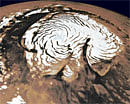Life or no life?

For all the triumph of NASA’s 1976 Viking mission, which put two unmanned spacecraft on Mars, there was one major disappointment: The landers failed to find carbon-based molecules that could serve as the building blocks of life. The complete lack of these organic molecules was a surprise, and the notion of a desolate, lifeless Mars persisted for years.
Now, some scientists say that conclusion was premature and perhaps even incorrect. They suggest that such building blocks – known as organic molecules, although they need not come from living organisms – were indeed in the soil but were inadvertently destroyed before they could be detected.
If true, that could cast the scientific conclusions of the Viking mission in a new light, especially since another Viking experiment claimed to have found living microbes in the soil. Most scientists discounted that possibility – how could there be life in soil devoid of the building blocks of life?
“That gospel of the Viking results has influenced our perspective of life on Mars for 35 years,” said Christopher McKay, a planetary scientist at NASA’s Ames Research Center in California and an author of the new findings, to be published in The Journal of Geophysical Research – Planets.
“What do they find? Nothing. But it turns out it was not really nothing.” The Viking 1 and Viking 2 landers scooped Martian soil samples and heated them, looking for organic compounds in the released gases. It found only two – chloromethane and dichloromethane – and the scientists concluded that the chlorine compounds were contaminants from fluids used to clean the spacecraft.
Stumbling on perchlorate
Then in 2008, NASA’s Phoenix Mars Lander unexpectedly found a chlorine chemical, perchlorate, in the planet’s arctic soil. In the new experiments, the scientists heated a mixture of perchlorate with soil from the Atacama Desert in Chile, often considered the closest thing on Earth to Mars. Chemical reactions destroyed organic compounds in the soil, producing mostly carbon dioxide and traces of chloromethane and dichloromethane, just like what the Viking landers had found.
“Now when we look back at the Viking results, it makes sense,” McKay said. “It was bizarre chemistry.” For veteran Mars researcher Gilbert V Levin, the new paper offers a measure of vindication. His Viking experiment added nutrients to the soil and measured releases of radioactive gas, which would occur as microbes ate the food.
Radioactive gas was released, but with the lack of organics in the soil, most concluded it had come from a nonbiological chemical reaction. Rafael Navarro-Gonzalez of the National Autonomous University of Mexico City and lead author of the new study, said the claim that Viking found life was still inconclusive. “It gives a big possibility,” he said, “but of course we don’t know.”
Levin acknowledged that nonbiological reactions could cause gas to be released but said the Viking experiment showed that whatever was producing the gas did so at temperatures plausible for microbes but not for other explanations.
Sceptical about the interpretation
But the leader of the Viking organics experiment, Klaus Biemann, a retired professor at MIT, doubts the new interpretation. He noted that the experiment also detected freon, which was certainly a contaminant, and that the presence of perchlorate at the Viking sites, far from where the Phoenix landed, was speculation.
More definitive answers could come with the Mars Science Laboratory, scheduled to be launched next year and to arrive in 2012. It will carry an experiment that will be able to separate perchlorates from organic molecules and thus allow it to identify the organics without destroying them.
New York Times News Service
An earth-like water cycle?
Planetary geologists in the United States have analysed data that suggest Mars was once home to a huge ocean of water, covering nearly one-third of its surface. Their evidence, a ring of dry river deltas and valleys all at a similar elevation, adds weight to the idea that the red planet once supported an earth-like water cycle.
Hints that an ocean once occupied the northern lowlands of ancient Mars first arose in the late 1980s. Scientists examining pictures of the surface claimed to recognize extensive shorelines and vast networks of river valleys and outflow channels feeding in the same direction. Other researchers used thermal physics to imply that such networks could only have been carved by a complete water cycle, fueled by one or more huge bodies of water.
Not all evidence has supported the idea of a Martian ocean, however. In the late 1990s, researchers studying high-resolution images of the proposed shoreline regions could not find any of the erosion and sediment normally associated with an ocean's edge. Nor have they since found the telltale coastal landforms seen on Earth, such as spits and wave-deposited ridges.
Jon Cartwright
Nature News
Deccan Herald is on WhatsApp Channels| Join now for Breaking News & Editor's Picks